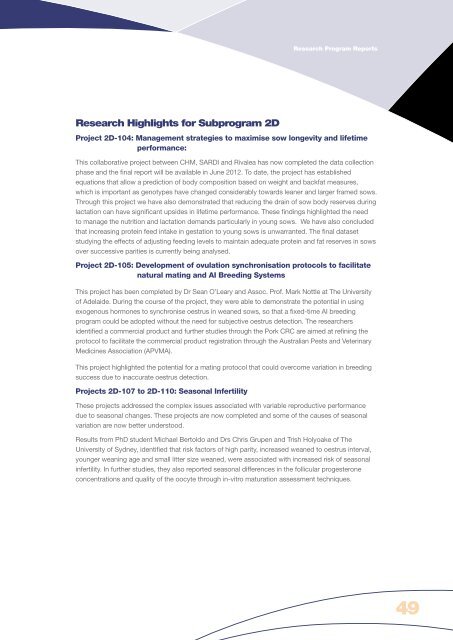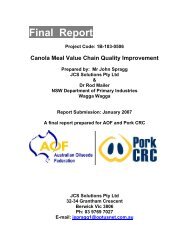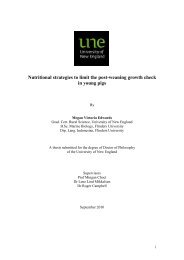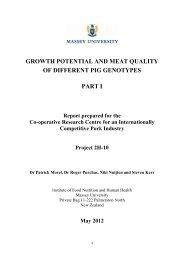annual report 09/10 - Apri.com.au
annual report 09/10 - Apri.com.au
annual report 09/10 - Apri.com.au
Create successful ePaper yourself
Turn your PDF publications into a flip-book with our unique Google optimized e-Paper software.
Research Program ReportsResearch Highlights for Subprogram 2DProject 2D-<strong>10</strong>4: Management strategies to maximise sow longevity and lifetimeperformance:This collaborative project between CHM, SARDI and Rivalea has now <strong>com</strong>pleted the data collectionphase and the final <strong>report</strong> will be available in June 2012. To date, the project has establishedequations that allow a prediction of body <strong>com</strong>position based on weight and backfat measures,which is important as genotypes have changed considerably towards leaner and larger framed sows.Through this project we have also demonstrated that reducing the drain of sow body reserves duringlactation can have significant upsides in lifetime performance. These findings highlighted the needto manage the nutrition and lactation demands particularly in young sows. We have also concludedthat increasing protein feed intake in gestation to young sows is unwarranted. The final datasetstudying the effects of adjusting feeding levels to maintain adequate protein and fat reserves in sowsover successive parities is currently being analysed.Project 2D-<strong>10</strong>5: Development of ovulation synchronisation protocols to facilitatenatural mating and AI Breeding SystemsThis project has been <strong>com</strong>pleted by Dr Sean O’Leary and Assoc. Prof. Mark Nottle at The Universityof Adelaide. During the course of the project, they were able to demonstrate the potential in usingexogenous hormones to synchronise oestrus in weaned sows, so that a fixed-time AI breedingprogram could be adopted without the need for subjective oestrus detection. The researchersidentified a <strong>com</strong>mercial product and further studies through the Pork CRC are aimed at refining theprotocol to facilitate the <strong>com</strong>mercial product registration through the Australian Pests and VeterinaryMedicines Association (APVMA).This project highlighted the potential for a mating protocol that could over<strong>com</strong>e variation in breedingsuccess due to inaccurate oestrus detection.Projects 2D-<strong>10</strong>7 to 2D-1<strong>10</strong>: Seasonal InfertilityThese projects addressed the <strong>com</strong>plex issues associated with variable reproductive performancedue to seasonal changes. These projects are now <strong>com</strong>pleted and some of the c<strong>au</strong>ses of seasonalvariation are now better understood.Results from PhD student Michael Bertoldo and Drs Chris Grupen and Trish Holyoake of TheUniversity of Sydney, identified that risk factors of high parity, increased weaned to oestrus interval,younger weaning age and small litter size weaned, were associated with increased risk of seasonalinfertility. In further studies, they also <strong>report</strong>ed seasonal differences in the follicular progesteroneconcentrations and quality of the oocyte through in-vitro maturation assessment techniques.49





